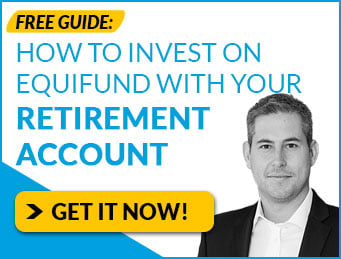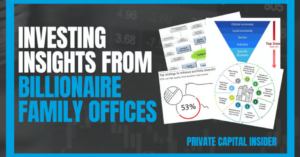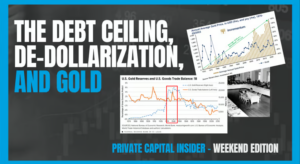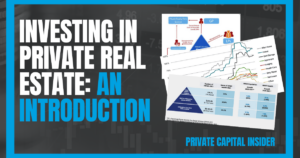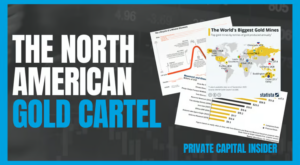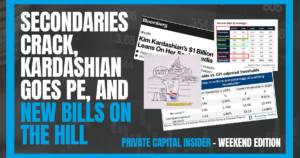Looks like many of our readers enjoyed our most recent issue of Private Capital Insider – ”Unlocking the Generational Code.”
If you enjoyed that issue, today, we’re going to be taking a look at…
-
Some recent news stories that build on some of the key concepts of how families build generational wealth…
-
The multi-trillion dollar generational transfer of wealth – what is it, why are people talking about it, and who will likely wind up with the lions share of it…
-
PLUS! An inside look at Listed Private Equity.
Let’s get into it,
-Equifund Publishing
An alternative viewpoint on “The Greatest Wealth Transfer in History”
This week, the New York Times published a familiar article with a familiar narrative regarding intergenerational wealth transfers.
For those unfamiliar, on a regular basis, media outlets like to talk about who has all the money, and who is going to inherit that money when they die.
Spoiler: It’s the families who are already wealthy!

According to the article.
In 1989, total family wealth in the United States was about $38 trillion, adjusted for inflation. By 2022, that wealth had more than tripled, reaching $140 trillion.
Of the $84 trillion projected to be passed down from older Americans to millennial and Gen X heirs through 2045, $16 trillion will be transferred within the next decade.
High-net-worth and ultrahigh-net-worth individuals — those with at least $5 million and $20 million in cash or easily cashable assets — make up only 1.5 percent of all households.
Together, they constitute 42 percent of the volume of expected transfers through 2045, according to the financial research firm Cerulli Associates.
That’s about $36 trillion as of 2020 — numbers that have most likely increased since.
Inevitably, these articles travel down one of a few familiar rabbit holes, namely:
-
Baby Boomers, who basically got super lucky by being born at the right time, and unfairly benefiting from a multi-decade bull market (especially in real estate)
-
The number of small business owners who have no succession plans, as their children don’t want to take over the family business
-
A lot of teeth gnashing over the unfairness of the U.S. tax code, which inevitably leads to some discussion about inequality
Most likely you’ve seen this “10,000 Baby Boomers retire every day, and 8-10% of them are small business owners” narrative…
And maybe you’ve seen the many books, courses, and the now growing #SMBTwitter community, all purporting to teach you how to buy these businesses from retiring business owners (if you haven’t, go check out Buy Then Build by Walker Deibel)
But here’s the story you haven’t heard, about this $30T+ wealth transfer…
In 2006, Richard Jackim and Peter Cristman – founders of the Exit Planning Institute – published “The $10 Trillion Opportunity: Designing Successful Exit Strategies for Middle Market Business Owners”
According to the authors,
A future retiree without a clear picture of potential requirements increases the chances of falling short of vital retirement needs.
Some individuals arrive at retirement with cash flow levels that are far less than their pre-retirement annual expenses.
Failing to adequately plan for your financial future after exiting your business will ultimately hinder your ability to have the third act of your life you might have envisioned.
Most business owners make decisions to sell based on assumptions and guesses about what they need when they retire; they simply hope and pray they will net enough from the sale of the business to accomplish their goals.
While this might seem like a “thanks, Captain Obvious” regarding the fact that many people arrive at retirement without enough money saved…
In my opinion, a significant portion of this alleged wealth transfer is going to be evaporated by continued inflation in housing, energy, healthcare, and market volatility.
Here’s why…
The United States spends nearly twice as much on healthcare than any other advanced nation in the world, yet it delivers worse health outcomes.

Of the massive $4.3T spent in 2021 – nearly 18% of GDP, and an average of $12,914 per capita – it’s estimated that surgical care, alone, represents nearly 30% of overall healthcare costs.

Statistically speaking, the single largest reason retirees run out of money before they run out of life is due to medical bills.
Unsurprisingly, healthcare is a top-of-mind concern for millionaire households, with the Spouse’s Health ranking as the top issue.

How does this relate to the transfer of wealth?
Answer: it is my opinion that far more of this wealth-to-be-transferred will be extracted by these end-of-life costs, as Boomers live longer and live sicker, and healthcare becomes increasingly expensive.
Instead of having surplus funds to give to their heirs, I think Boomers are far more likely to be forced to spend it on themselves in order to maintain their quality of life in retirement.
According to the 2023 Charles Schwab Modern Wealth Survey, when respondents were asked more generally how much money it takes to be wealthy in America, their responses averaged out to $2.2 million, nearly four times what the self-described wealthy reported about their own net worth!
Schwab calls this the “Wealth Paradox”
When people think about managing their finances and building wealth, it’s so much more personal than just money and investments.
Americans today aren’t as worried about keeping up with the Joneses, and more importantly, they understand that they can be happier with fulfilling experiences and relationships, even if they have less money.
Source: Charles Schwab
To reiterate the point I made in “Unlocking the Generational Wealth Code,” the secret to passive income is “arbitrage.”
As long as you have a cash flowing asset that you can use as collateral, you have a significant advantage when it comes to building – and protecting – your wealth.
Let’s take a look at the numbers behind Household Wealth in America.
According to ING, household wealth is $35 TRILLION higher than it was before the pandemic.

Notice what two asset classes make up the above chart? Non-financial assets (like real estate) and corporate equities.
Let’s take another look at this same trend, but going back to 2010, from Gavekal Research:

As we can see, real estate makes up a significant portion of household wealth (nearly 30%), with corporate equities around 15%.
But what I find more interesting is the household ownership of U.S. equities.
From Goldman Sachs:

Depending on the time series you look at, households are collectively the largest owners of U.S. equities. But the devil is certainly in the details.
According to a 2019 article from the NY Times, the top 1% of Americans in wealth controlled about 38 percent of the value of financial accounts holding stocks, with the top 10 percent controlling 84% of all Wall Street portfolios’ value.
So what does this have to do with building generational wealth?
It’s called “Buy, Borrow, and Die” – a classic strategy for how Insiders avoid taxes.
As a reminder, to create an arbitrage opportunity, you need to have the following criteria in place:
-
An income-producing asset (such as an operating business, real estate, insurance policy, and bonds), or depositors of checking, savings, and CDs, that are willing to accept low, if any interest, in return for stability
-
A lender that is willing to lend against the asset as collateral, in order to obtain leverage
-
Income that is larger than the loan payments and expenses related to the asset
Generally speaking, this means buying real estate, operating companies, and publicly traded securities (which serves as the asset base)…
Then, whenever you need capital, instead of SELLING any of these assets, simply borrow against them.
By doing this, you get a double tax break, as you’re not only not paying capital gains from the sale of the asset…
The loan is not counted as taxable income (because debt is not taxed)!
But wait, it gets better. According to the tax law, upon your death, your heirs benefit from what’s called a step-up in the cost basis.
This means the heirs can now dispose of the asset completely tax-free, as there would be no “capital gain” with the cost basis reset to its present-day value.
OR… it means the heirs can simply lever up the asset again, and borrow more against it to create 100% non-taxable “income.”
While tax evasion scandals tend to catch the public eye, legally approved forms of tax avoidance are the major tool of wealth preservation.
Morris Pearl, 60, a former managing director at BlackRock, the largest asset management firm in the world, points to himself as an example.
“I have right now in my stock portfolio, some stock that my wife’s father, who died a long time ago, bought in the 1970s — that investment has gone from a few thousand dollars to many hundreds of thousands of dollars,” Mr. Pearl noted.
“I’ve never paid a penny of taxes on all that, and I may not ever, because I might not sell and then my kids are going to have millions of dollars in income that’s never taxed in any way, shape or form.”
Mr. Pearl noted that people with only a couple of million can use “securities-based loans,” borrowing low-cost funds from banks using the value of a given investment portfolio as collateral. “You just loan yourself money,” he explained, and in many if not most cases, the portfolio’s rate of return exceeds the rate of interest on the loan.
It’s understanding how these types of wealth preservation strategies work on the back end, so you know what to do on the front end to build the asset base needed to implement those strategies.
And that, in a nutshell, is what becoming a Private Capital Insider is all about.
Why Investors Like Publicly Traded Private Equity vs Unlisted Funds
For investors seeking exposure to private equity strategies, generally speaking, you’ve got two choices.
-
Private Markets: Invest in individual private equity funds (most of which typically require high minimum investments)
-
Public Markets: Invest in publicly traded funds, like Blackstone, KKR, Apollo Global Management, and Carlyle
But we haven’t talked much about the fee structures embedded inside these investment vehicles.
Generally speaking, most funds charge the industry standard “2 and 20” – which is a 2% annual management fee and 20% of the upside (called the “carry”).
But again, the devil is usually in the details. Namely, how is that 2 and 20 distributed to the employees of the company and its shareholders?
And perhaps more important, how can this return stream be constructed to unlock maximum value?
Although generating profit on investments is the essence of these specialty financiers, it tends to be inconsistent.
Blackstone’s realized performance revenue, which includes carry, has oscillated between a recent trough of $1.5 billion in 2016 and $4.5 billion last year.
Compare that with the steadier stream of fees that [CEO of Blackstone] Schwarzman and his rivals charge annually for managing money.
JPMorgan analysts assign a multiple of 26 times to Blackstone’s recurring earnings and just 8 times to the lumpier, performance-related ones.
That’s why some firms are restructuring the return stream to offer investors more of what they value (income), and less of what they discount (uncertainty).

KKR – co-founded and chaired by Henry Kravis and George Roberts – used to throw all the revenue into one big pot and paid out 40% as compensation to staff.
In February 2021, however, it started giving employees 60% to 70% of carry and just 20% to 25% of fee-related income, while keeping overall pay steady relative to revenue.
However, despite these moves, earnings multiples at Blackstone, KKR, Apollo and Carlyle are still about one-third below the S&P 500 Index, and roughly in line with the average discount since 2013.
Taken to its logical extreme, all the performance-linked payouts should go to insiders.
It would leave a publicly traded unit composed almost entirely of recurring management fees and other steady income, like BlackRock (BLK.N) or T. Rowe Price (TROW.O), which trade at much higher valuation multiples.
Think about this for a moment. Would you rather own a financial product that offers…
-
Money Now: You get to invest in the business that earns a guaranteed 2% per year, based solely on the number of assets under management, or…
-
Money Later: You get whatever upside happens after management gets paid, minus 20%?
I think it’s fair to say that many would choose the “guaranteed” income from management fees, regardless of performance.
This, in a nutshell, is the source of many perverse incentives for fund managers…
And it’s one of the ways Bankers are able to engineer incredible wealth-creation opportunities for themselves, by shifting the risk to someone else (in this case, the Limited Partners).
Now, that’s not to say there isn’t a legitimate reason for fund managers to earn a management fee and carry for the services they provide…
But consider the following: a 2% annual fee on $1bn AUM is $20m of income per year, regardless of performance!
Sign me up for that business model, right?
However, for those of us who can’t get those kinds of deals, the next best option is to look for ways to skip the middleman and invest directly.
For example, had you invested in Berkshire Hathaway when it started, it offered essentially a Private Equity strategy – which is investing in (or buying) other businesses – without the 2 and 20 fees.
And while we can’t claim any of the offerings listed on Equifund will produce returns like Berkshire, they offer a similar value proposition – the opportunity to invest in select companies, each managed by an executive whose job is to deploy investor capital to maximize shareholder returns through acquisition of both real assets (like real estate and operating companies) and financial assets (like Golden Cashflow Contracts)…
All without the fee drag on your portfolio, which would otherwise come from investing in a PE fund pursuing a similar strategy.




 |
|